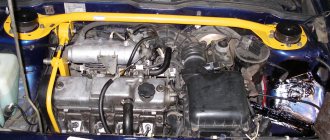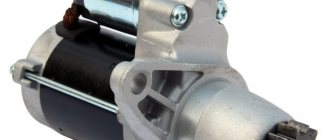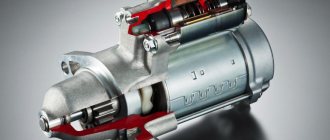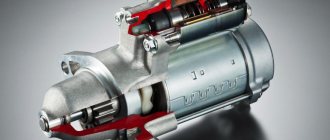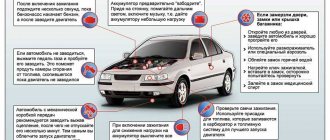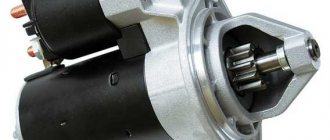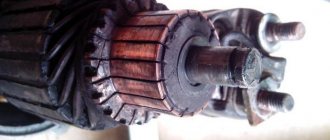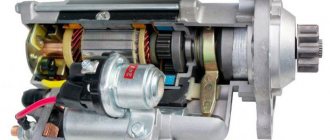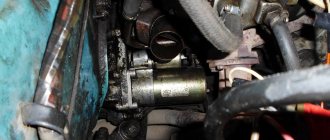09.10.2013
Starter-battery-ignition circuit diagram
Probably the most unpleasant thing that can happen is when you get into the car with thoughts of a good trip, turn the ignition key, and in response there is deep silence. And at this moment you remember all the swear words and pour them on your car. And it’s even worse when it’s -30 ºС outside and you’re already frozen to the bone. But let’s not talk about sad things, let’s just break down the main reasons for a non-working starter.
But! Before doing this, be sure to pay attention to other possible causes of the malfunction! Since in 90% of cases the problem of a non-working starter lies in completely different faulty elements.
Expert advice: checking the operation of the starter
To identify the reason why the starter does not turn, experts advise using the following instructions:
Many things can disrupt the operation of the VAZ 2114 starter: the armature does not turn, the solenoid relay has failed, noise has appeared, etc. Is it really necessary to immediately go to a service station or can this be done repair yourself? We will try to find answers to all these questions in our article.
If you decide to independently repair this small but very important part, first of all you need to familiarize yourself with its structure and operating principle. Regardless of the make and model of the car, the starter has the same design and performs the same function, only the dimensions differ
A car starter is essentially an electric motor. Its stationary part is the stator, in the housing of which there are 4 magnets that act as poles, and a movable armature. And after the ignition is turned on, another important part - the retractor relay - gives the corresponding signal, and the armature begins to rotate, constantly accelerating. Bendix ensures the engine flywheel meshes.
Bendix starterThe rated power of the starter is 1.55 kW, and the current strength depends on a number of indicators. For example, during idling it is only 80 A, under normal loads it is about 150 A. If you increase the power to the maximum, the current will reach 350 A. During frosty periods, the starter will be in an inhibited state, and the current will be 500 and even 700 A. Home The task is to create torque. It drives the crankshaft until the combustible mixture ignites. Naturally, at this time the part experiences enormous loads, and one fine day the VAZ 2114 starter no longer turns on.
What else do you need to know about relays?
Since the starter consumes quite a powerful current, the integrity of its elements should be checked every 100 thousand kilometers or every 3 years. During this time, slight fluctuations in voltage may occur in the mechanism, which can cause the relay to fail.
You can check its functionality by a characteristic click. It happens that when starting, the starter continues to work. In this case, you will hear a sharp squeal. This indicates that the retractor has failed. The mechanism cannot return to its reverse position.
TRIGGER DEVICE
The starter on a VAZ is an electric motor with a mechanical drive for engagement with the flywheel of an internal combustion engine (ICE). The device itself consists of the following parts:
- Main building. It is a metal hollow cylinder, inside of which the electric motor parts are located;
- Stator. The stator is a winding made of thick copper wire, between the turns of which steel cores are placed. The winding is located inside the housing along its walls;
- Rotor. The rotating part of the mechanism, steel plates made of electrical steel are assembled on the shaft, and a winding is located inside the plates. It is also called “anchor”. The armature rotates in the housing bushings - front and intermediate; the rear support of the entire shaft is a bushing in the gearbox housing. There is also a collector on the rotor, which is a set of plates. A magnetic field is created on the collector, which sets the armature in motion;
- Bendix. A gear device that meshes with the flywheel of an internal combustion engine and ensures engine rotation. Placed on the rear of the rotor shaft;
- Brush unit. In model 2114, there are 4 brushes in the assembly. The brushes interact with the rotor commutator, and it is they who create the electromagnetic field;
- Solenoid relay. Unlike a conventional relay, the solenoid relay performs two functions at once - it closes and opens the contacts of the electrical circuit, and with the help of the core it moves the bendix gear to engage with the flywheel of the internal combustion engine.
This is interesting: Replacing a fog light: your lack of experience is not a hindrance
Other reasons why the starter may not respond when the ignition is turned on
In some cases, there have been malfunctions in the operation of automobile anti-theft systems (car alarms, immobilizers). Such systems simply block the supply of electric current to the starter after the security mode is removed. At the same time, the diagnostics shows the full functionality of the battery, power contacts and other elements of electrical equipment that are involved when starting the engine from the starter. For an accurate determination, it is necessary to directly supply power from the battery to the starter, that is, bypassing other systems. If the starter works, then there is a high probability of failure of the car's anti-theft system or immobilizer.
The next item to check is the solenoid relay. If it breaks, the starter can:
Bendix and retractor
The above symptoms will indicate that the fault is localized to the solenoid relay or the bendix does not engage the flywheel. Note that in the case of Bendix, a more characteristic sign is that the starter crunches and does not turn the engine. Another common sign of a bad starter is that the starter buzzes but does not turn the engine.
To check the traction relay, voltage must be supplied from the battery to the power terminal of the relay. If the engine starts to turn over, then the retractor starter is obviously faulty. A frequent breakdown is the burning of the contacts. To eliminate it, you will need to remove the relay to clean the nickels. After cleaning, you must still be prepared to quickly replace the traction relay, since in the factory the contact pads are covered with special protection that resists burning during operation. Stripping will mean that the specified layer is removed, as a result of which it is difficult to predict the moment when the retractor coins will burn again.
Now let's turn our attention to the starter bendix. Bendix is a gear through which torque from the starter motor is transmitted to the flywheel
The Bendix is mounted on a single shaft with the starter rotor. To better understand, it is necessary to understand how a starter works. The principle of operation is that after turning the ignition key to the “start” position, current is supplied to the solenoid relay. The retractor transmits voltage to the starter winding, resulting in the engagement of the bendix (gear) with the flywheel ring gear (flywheel ring gear). In other words, two gears are combined to transmit the starter torque to the flywheel.
Wear of the Bendix gear means that there is no normal connection with the flywheel ring. For this reason, a cracking sound may be heard when starting the engine, and the starter may spin freely without engaging and buzzing. A similar situation arises if the teeth of the flywheel rim are heavily worn. The repair involves disassembling the starter to replace the bendix and/or removing the transmission to replace the flywheel. To check the bendix yourself, you will need to close two power contacts on the traction relay. The electric current will bypass the relay, which will determine the rotation of the starter. If the starter rotates easily and hums, you should check the quality of engagement of the bendix with the flywheel.
Simple check on the car
Initially, it is important to find the unit itself among the elements of the engine compartment. In most cases, the starter housing can be easily accessed from above by opening the hood. Before the procedure, you need to check the condition of the battery.
The voltage of a fully charged battery that is not under load is 12.6-12.9 Volts. After this, you can go directly to checking the starter. To do this you will need a voltmeter and a long screwdriver with a rubberized handle.
This can be done in two ways.
Method No. 1
Here we need a voltmeter and an assistant.
The check must be carried out in the following order:
- Locate the positive terminal of the solenoid relay on the starter unit. It looks like a large bolt with a thick braided wire attached to it.
- Connect the red wire of the voltmeter to it.
- Attach the black cable of the device to the ground of the car.
- After this, ask an assistant to turn the ignition key. At this time, the voltmeter should show 12 volts, and the starter should make characteristic knocking noises. If the voltage is lower, then the problem is most likely in the battery or ignition switch.
Method No. 2
To check in another way, you will need a long screwdriver.
Here you need to follow the following algorithm:
- Disconnect the wire that comes from the ignition switch from the solenoid relay bolt.
- Using the metal part of a screwdriver, connect this point to the positive terminal of the relay. This will open a direct path for current from the battery.
- If after this the engine starts, this will indicate a malfunction of the solenoid relay or ignition switch.
The methods described above allow you to diagnose the starter without any problems without removing it from the car. Periodic monitoring of the unit allows you to prevent the occurrence of unpleasant situations right on the road under the most unfavorable circumstances. It should be remembered that if several parts fail at once, it is better to purchase a completely new device.
Source
Starter and additional relay VAZ 2114: why the starter does not turn
The starter on the VAZ 2114 is the engine starting device; without it, the engine can only be started from a pusher or in tow. Its failures cause a lot of trouble for car owners, but the reason for the inoperability does not always lie in the starting mechanism itself - there are other breakdowns, for example, a non-working relay.
Starter
Trigger device
The starter on a VAZ is an electric motor with a mechanical drive for engagement with the flywheel of an internal combustion engine (ICE). The device itself consists of the following parts:
- Main building. It is a metal hollow cylinder, inside of which the electric motor parts are located;
- Stator. The stator is a winding made of thick copper wire, between the turns of which steel cores are placed. The winding is located inside the housing along its walls;
- Rotor. The rotating part of the mechanism, steel plates made of electrical steel are assembled on the shaft, and a winding is located inside the plates. It is also called “anchor”. The armature rotates in the housing bushings - front and intermediate; the rear support of the entire shaft is a bushing in the gearbox housing. There is also a collector on the rotor, which is a set of plates. A magnetic field is created on the collector, which sets the armature in motion;
- Bendix. A gear device that meshes with the flywheel of an internal combustion engine and ensures engine rotation. Placed on the rear of the rotor shaft;
- Brush unit. In model 2114, there are 4 brushes in the assembly. The brushes interact with the rotor commutator, and it is they who create the electromagnetic field;
- Solenoid relay. Unlike a conventional relay, the solenoid relay performs two functions at once - it closes and opens the contacts of the electrical circuit, and with the help of the core it moves the bendix gear to engage with the flywheel of the internal combustion engine.
Malfunctions
There are various signs of a starter malfunction on a VAZ 2114:
- The starter does not work at all, that is, it does not show any signs of life. The stator or rotor winding may burn out and power may not be supplied to the electrical part of the device;
- The starter turns, but does not engage; often the Bendix idles, not engaging with the flywheel. Usually the cause is the bendix itself - it should only rotate in one direction on its axis;
- The starter does not operate when the VAZ 2114 key is turned. If dry, quiet clicks occur, then both the VR solenoid relay and the relay responsible for turning on the circuit by turning the key in the ignition switch may be faulty. If the VR is faulty, the clicks are usually louder;
- The starter turns slowly, but can stop quickly. The stator or armature winding is short-circuited, the rotor has play in the bushings. There may also be a bad weight of the internal combustion engine with the body or a weak battery, but this does not apply to the starter;
- The engine starts with a grinding or crunching sound. Most often, such a start indicates wear of the teeth on the Bendix gear or the teeth of the engine flywheel.
How to make the starter close while driving
If the starter does not start naturally, you can start the car using alternative methods. For example, when the problem is a faulty coil or relay, you can make the short circuit needed to start the engine by manually pushing the car. Of course, you can only do this yourself if the car is on a descent, but it’s not worth the risk. It’s better to just ask random passers-by for help, so that they put their hands on the trunk and try to move the vehicle forward while you turn the ignition key and engage first gear. The higher the speed the assistants give the car “from the pusher”, the easier it will be to start it.
An alternative method to pushing is towing. In order to carry it out, you will need a cable and another car. If an unexpected stop occurs on the road, try to stop one of the drivers passing by. Surely someone won't refuse to help
Towing should be done very carefully, because once your car starts, it will begin to accelerate. Immediately inform the driver helping you about this and gradually slow down
When you stop, do not turn off the engine.
Let's summarize
Using these simple methods, you can independently check the removed starter as a whole and each of its elements separately. As you can see, there is nothing complicated here, no fancy instruments are needed either, except for the E 236, but this is a last resort.
I was able to prove that with such a diagnosis, the most difficult process may be the process of removing the starter from the car? – If not, write your opinion in the comments.
Such performance testing methods are suitable not only for classic automobiles such as VAZ, but they can also be successfully used on foreign cars. In most cases, the design of starters is the same everywhere, so diagnostic methods are similar everywhere.
Thank you all for your attention. If you have any questions, ask them in the comments. I'll be happy to help you.
Causes and troubleshooting
Let's look at the reasons why the starter on a VAZ-2114 does not turn.
The causes of the malfunction may lie not only in it, but also in other elements involved in the circuit.
Moreover, the behavior of the circuit itself when closed can tell you where to look for a breakdown.
The key is in the “start” position and the starter does not start.
If, after turning the key to the “start” position, the starter does not spin, but the solenoid relays are activated (a distinct click is heard, indicating that the armature has moved), and the lamps on the dashboard have noticeably dimmed, then the reason may be:
- In a discharged battery
. Electric consumers left turned on at night drain the battery and the amount of its energy is not enough to power the electric motor. Severe frosts can also affect the battery (exposure to sub-zero temperatures leads to an increase in resistance in the battery). To start a car you need to either charge the battery or “light” it from another car; - In severe oxidation of contacts
. Or insufficient contact at the battery terminals and the solenoid relay terminals, including ground. This causes an increase in resistance at the connection points, so the energy from the battery will not be enough to turn the electric motor. In order for the starter to start turning, it is necessary to check all the connections between the battery and the starter, clean and tighten them if necessary. To prevent oxidation, it is necessary to lubricate the battery terminals; - Burning of the contacts inside the retractor relay (nickels)
. For this reason, when the circuit is closed by an armature, strong voltage losses occur at the contact points. To fix the problem, you will have to remove the starter, disassemble the solenoid relay to clean the nickels, or simply replace it; - The contact brushes of the electric motor are heavily worn
. Due to this malfunction, the contact between the brush block and the rotor is broken and the electric motor will not rotate. This can all be “cured” by replacing the brushes; - There is a short circuit in the motor windings
. The only way to restore functionality is to rewind the windings or replace the burnt-out starter with a new one.
When you turn the key, all warning lights come on.
If, when you turn the key, all the warning lights are on, but even the relay does not work, this may indicate:
- Blown fuse of the power circuit leading to the ignition switch or insufficient contact at the connection points. In this case, the voltage from the battery will not flow to the lock, and, accordingly, to the coil of the solenoid relay. Therefore, first of all, you should check the condition of the fuse and, if necessary, replace it, and also check all connection points;
- Burning of the ignition switch contact group. For this reason, the circuit will not close and the relay will not work. You can check this quite simply - you need to use a screwdriver to connect the terminals on the solenoid relay (in essence, apply voltage to the electric motor, bypassing the relay). If at the same time the starter starts to turn, then the reason is in the lock. Additionally, you can check by disconnecting the wires from the lock and short-circuiting those that lead to the relay (but for this you need to know where which wire is). If the short circuit causes the starter to turn on, then the fault definitely lies in the lock and can be eliminated by replacing the burnt element with a new one;
- Closing the coil of the solenoid relay. As a result, the latter ceases to perform its functions. You can check this by closing the contacts on it with a screwdriver. If it is determined that the relay does not work, then the latter is replaced.
- Anchor jamming. The magnetic field cannot draw it in and the circuit does not close. The test is done as usual - by shorting the terminals. Everything can be eliminated by disassembling the relay and cleaning it.
These are the main reasons why the starter does not turn. If you sequentially check all the elements of the circuit, the fault can be identified very quickly.
DTOZh replacement procedure and timing
The procedure for replacing the DTOZh may differ depending on the car model. At the VAZ, to carry out the process, you need to prepare several tools, including the obligatory set of wrenches.
According to the classic scenario, the coolant will have to be drained, otherwise replacing the DTOZH cannot be called correct. Although there are several replacement options that do not involve draining.
As mentioned above, one of the DTOZH is located in the thermostat. It screws in from the side. The second is located a little lower, wrapped in the cylinder head.
A little about the timing of replacement of DTOZH. If we are talking about a regulator that goes to the pointer, then it must be replaced at the very moment when the temperature values go astray. This is easy to check: for example, when the engine is cold, the coolant needle tends to the red zone or simply wanders. This is an error and requires correction, i.e., replacement of the sensor.
In some cases, it also happens that it is not the regulator itself that is to blame, but the wiring or contact. You need to check everything, and only then decide whether to change it or not. Testing the wiring is also easy: the wires are disconnected from the DTOZH, the ignition is turned on and a short to ground is made. If the arrow jumps up, then everything is in order with the wiring.
The second DTOZH changes if the machine itself is not working properly. For example, the speed of a cold engine does not increase, but when it is hot it reaches a value of 1500 rpm. Fault number 2 can also be judged by the cooling fan, which turns on too early or does not do so at all.
Temperature controllers that have been removed are easiest to check. They must be immersed in boiled water heated to certain values, then connect an ohmmeter to measure the resistance coming from the DTOZH.
The starter clicks but does not turn - the main reasons and diagnostics
Current consumption is:
- no more than 375A at rated power;
- up to 700A in inhibited state;
- up to 80A at idle.
There are 4 main basic faults. Let's look at each in more detail.
Anchor not working
Severe wear on the starter armature
This is evidenced by a completely discharged battery, oxidized wire terminals, and their weak attachment to the terminals.
Relay coil short circuit
Closing the relay winding. A break or short to ground cannot be ruled out. In this case, the starter will not turn or click. If you need to drive urgently, turn on the ignition and close the starter directly.
Ignition switch with key in VAZ-2114
The lock switch contacts do not close.
Malfunction of switching elements
When the starter is turned on, the anchor does not move and the traction device is inactive. In this case, the symptoms are:
- The traction relay is activated and deactivated when the mechanism starts.
- The anchor rotates, but the flywheel does not move.
- Noise inside the housing when the armature rotates.
Fuel pump and related
The first malfunction is insufficient pressure in the fuel rail. During operation, the pump heats up and begins to pump poorly. Because of this, the car may stall and not start.
The pressure is checked by installing a pressure gauge. At idle in the system 2.5 atm, in power modes it should increase to 3. With a faulty pump, these indicators may differ between a cold and hot engine. Check in the mode in which problems arise.
One of the problems of the VAZ 2115 is the bypass valve, which, if faulty, begins to “let in” fuel on a heated engine. Bottom line: fuel pressure drops and takes time to build up. Symptoms are a long period of production or its complete absence.
Another reason for a drop in pressure in the system may be a clogged fuel filter or strainer in the tank. When heated, dirt expands and clogs the fuel flow.
Signs of starter malfunction
- The solenoid relay turns on but makes a knocking noise. It is possible that the relay winding has poor contact with ground. If the wiring and battery are in good condition, you need to open the cover of the starter switch in the relay and stretch or change the ground wire.
- The solenoid relay is activated, but the motor does not turn over. Remove the brush holder cover and check the brushes. In the normal state of the brush, it is pressed tightly against the commutator. If the brush is worn out, the spring will rest against the brush holder and there will be no necessary contact. The height of the brushes must be no less than 12 mm. Replace worn brushes. If there are scratches or marks, the commutator must be sanded. If there is no result, it is better to have the engine checked by a specialist; without special equipment and appropriate skills this will be difficult to do.
- The anchor does not rotate or rotates slowly. There may be a voltage drop in the electrical network. If the electricity supply is in normal condition (battery, terminals, ground wire and brushes are checked). The solenoid relay is disassembled. The contacts are checked (they may burn), the contact disk is turned over to the other side, and the contact bolts are rotated 180 degrees.
- The solenoid relay does not work: The armature winding of the relay has burned out, most often this occurs due to the short circuit of the winding turns. You can determine this by connecting the contacts with a screwdriver. If the result is negative, the relay armature must be replaced.
- The contacts (nickels) are burnt or oxidized. In this case, the solenoid relay is disassembled. Inside there is an armature (a metal cylinder with an internal winding), a spring and a rod. The rod and the hole through which it runs are most often clogged with oxide. Clean with fine sandpaper. The nickels may be oxidized, and their contact surface may also be burnt. Clean and replace if necessary.
- The freewheel (Bendix) may be slipping. It should be disassembled and replaced. If possible, repair broken parts (pushers, rollers, gears). Clean and polish the surface of the coupling.
During operation of the starter, and especially in the cold season. If the starter has not been disassembled for maintenance for a long time, condensation begins to accumulate in it over time. This will not only lead to the formation of oxide, but also to the fact that ice may form inside in cold weather. In this case, of course, you can tap the retractors with a hammer or warm up the starter housing with a torch or blowtorch. But this is temporary, not immediately, but in a month this breakdown will show itself again.
From this we can draw a conclusion. It is necessary to carry out vehicle maintenance on time (especially before the onset of cold weather), this will avoid many unnecessary problems with the car.
7.4.4 Possible malfunctions, their causes and methods of elimination / VAZ 2115
| Cause of malfunction | Elimination method |
| When the starter is turned on, the armature does not rotate, the traction relay does not operate | |
| 1. The battery is faulty or completely discharged | 1. Charge the battery or replace |
| 2. The battery terminals and wire tips are heavily oxidized; tips are loosely tightened | 2. Clean the pole terminals and wire lugs, tighten and lubricate with Vaseline |
| 3. Interturn short circuit in the pull-in winding of the traction relay, its short circuit to ground or open circuit | 3. Replace the traction relay |
| 4. Open circuit in the power supply circuit of the starter traction relay | 4. Check the wires and their connections in the circuit between plugs “50” of the starter and ignition switch |
| 5. The contact part of the ignition switch is faulty: contacts “30” and “50” do not close | 5. Replace the contact part of the ignition switch |
| 6. Jamming of the traction relay armature | 6. Remove the relay, check the ease of movement of the armature |
| When the starter is turned on, the armature does not rotate or rotates too slowly, the traction relay is activated | |
| 1. Battery is faulty or discharged | 1. Charge the battery or replace |
| 2. The battery poles and wire tips are oxidized; tips are loosely tightened | 2. Clean the pole terminals and wire lugs, tighten and lubricate with Vaseline |
| 3. The lugs of the wire connecting the power unit to the battery are loose | 3. Tighten the fastenings of the wire lugs |
| 4. The contact bolts of the traction relay are oxidized or the nuts securing the wire lugs on the contact bolts are loose | 4. Clean the contact bolts, tighten the wire fastening nuts |
| 5. Burnt commutator, stuck brushes or worn out brushes | 5. Clean the commutator, replace the brushes |
| 6. Open circuit or short circuit in the armature winding | 6. Replace the anchor |
| When the starter is turned on, the traction relay is activated and switched off repeatedly | |
| 1. Battery is low | 1. Charge the battery |
| 2. Open or short circuit in the holding winding of the traction relay | 2. Replace the traction relay |
| 3. Large voltage drop in the power circuit of the traction relay due to severe oxidation of the wire tips | 3. Check the wires and their connections in the circuit from the battery to plug “50” of the starter |
| When the starter is turned on, the armature rotates, the flywheel does not rotate | |
| 1. Freewheel slipping | 1. Check the starter on the stand, replace the clutch |
| 2. Reducer gears are damaged | 2. Replace damaged gears |
| Unusual starter noise when turning armature | |
| 1. Excessive wear of the bearing shells of the armature and drive shafts | 1. Replace liners or covers and supports with liners |
| 2. Excessive wear of the drive shaft bushing in the clutch housing | 2. Replace the bushing |
| 3. The starter is loose or its cover on the drive side is broken | 3. Tighten the fastening nuts or replace the starter |
| 4. The starter is mounted skewed | 4. Check the starter mounting |
| 5. Reducer gears are damaged | 5. Replace damaged gears |
| 6. Damaged drive gear teeth or flywheel ring gear | 6. Replace drive or flywheel |
| 7. The gear does not disengage from the flywheel: - jamming of the clutch on the splines of the drive shaft - jamming of the traction relay armature | 7. Do the following: - clean the splines and lubricate them with engine oil - replace the traction relay or eliminate the jam |
The starter of VAZ 2108, 2109, 21099, 2113, 2114, 2115 does not turn
VAZ 2115 starter repair Part 1
BSK VAZ 2113 2114 2115. BI BSK does not work. Finalization. The correct solution to the problem with the indication.Block
Solenoid Relay. Repair in 5 minutes. Traction Relay 2114. Clean the nickels
VAZ 2115 (Lada Samara, 2114) will not start
How to check with a multimeter
Often, the average car owner does not have the opportunity to check with a test light or a flaw detector, so the most accessible methods of checking the starter are checking with a battery and a multimeter . We will check the brushes and windings of the starter for short circuits in the megger or continuity modes, and the relay windings for low resistance.
Checking the starter with a multimeter
Disassembling and checking all starter parts
So, how to check the starter with a multimeter - you just need to disassemble it and measure the resistance between :
- brushes and plate;
- winding and housing;
- collector plates and armature core;
- starter housing and stator winding;
- the ignition switch contact and a permanent plus, also known as the shunt bolt for connecting the excitation windings of the starter motor (the condition of the relay pull-in winding is checked). If working properly there should be 1-1.5 ohms;
- the ignition connection terminal and the traction relay housing (the holding winding of the traction relay is checked). It should be 2-2.5 ohms.
It is worth noting that the resistance of the armature windings is negligible and cannot be determined with a conventional multimeter, so you can only ring the windings for the absence of a break (each lamella of the collector must ring with all the others) or check the voltage drop ( should be the same for all ) on adjacent lamellas when applied to them DC (about 1A).
Finally, we present for you a summary table that contains information on what methods can be used to check this or that part of the starter.
| Tested elements and methods | Solenoid relay | Anchor | Starter brushes | Starter winding | Bendix |
| Multimeter | |||||
| Visually | |||||
| Battery | |||||
| Bulb | |||||
| Mechanically |
I hope this information helped you learn how to test the starter yourself in a garage, having only a battery or a multimeter at your disposal. As you can see, checking the starter for functionality may not require professional equipment or knowledge of electrical circuits. need basic skills in using an ohmmeter and a tester with a control light. But for professional repairs, you also need a PYA - an anchor testing device.
Why doesn't the starter turn or click the solenoid relay?
In practice, most of the problems and malfunctions when the starter operates are problems with the electrical part. Mechanical failures are less common. Problems with starting the vehicle's power unit, which are caused by electrical faults.
If you cannot start the car, you need to check its battery for functionality, since the starter is powered from it. If the power supply is insufficiently charged, the characteristic sounds of the engine starting system may be completely absent. You can measure the battery charge using a voltmeter. If it is less than 9V, it is necessary to recharge the battery, otherwise further loss of capacity may negatively affect its operation. If there is no tester, you can determine how charged the battery is by the brightness of the headlights, although this requires some experience. If, when the high beam is on and the ignition key is turned in the lock, the headlights begin to shine weaker, it means that the battery charge has decreased significantly. If you suspect that a charged battery is not powering the car's electrical system, it is necessary to clean its terminals to remove the oxide film from them, which is causing poor contact.
If the starter clicks but cannot turn the engine, you need to test the solenoid relay. In addition to the failure of this part, problems may arise with the power cable. To determine the functionality of the relay, it is recommended to connect it directly to the battery terminals. If the traction works with such a connection, the cause of the problem must be sought in the power system (damage to the wires, burnt relay contacts, a malfunction in the ignition switch). After troubleshooting, the engine starting system will function properly.
Insufficient contact or its absence leads to a loss of current in the vehicle’s electrical network, which is why its consumers function incorrectly
Therefore, it is necessary to periodically pay attention to all connections in the on-board network. For normal functioning of the starter, a current of approximately 200A is required.
At a lower starting current, only the pull-in winding of the relay is activated. However, the power unit cannot start.
Low battery
The most common problem in this case. It is especially relevant in winter. You need to charge, replace the battery, warm it up (if the problem occurs in winter) or light it.
The main sign of a non-working device will be the noise of the relay operating when turning the ignition key! But if the battery is “healthy” and there is sound, then see the next point.
In general, starting the engine in winter is a separate topic, which will be the subject of an entire article!
Noise when rotating armature
In this case, check the condition of the drive shaft and armature bearing liners. Replace worn elements. The starter may have become loose or its cover at one end may be broken. Because of this, the mechanism works incorrectly. Inspect the flywheel itself. There should be no wear on its teeth. If present, the flywheel needs to be replaced. It happens that the gear does not disengage with it. In this case, the cause of the malfunction is in the clutch. It jams on the shaft splines. The VAZ-2115 starter relay can work normally. Clean the splines and treat them with oil. This helps eliminate jamming.
Characteristic
Every car has an ignition system. However, it's not just spark plugs, a coil and armored wires. This system also includes a starter. The VAZ-2115 is also equipped with it. On Samara-2 cars it is of a gear type. The element is assembled with a traction relay and a drive mechanism.
The starter interacts with the ignition switch and the engine, being a kind of intermediate link. The main purpose of the element is to create the necessary torque for the engine, which will give the internal combustion engine the ability to work independently.
Expert advice: checking the operation of the starter
To identify the reason why the starter does not turn, experts advise using the following instructions:
- We check the wire contacts on both the starter and the battery for oxidation of the wiring:
- clean the battery terminals;
- clean the electric starter contacts.
- Checking the battery charge:
- measure the capacity of the cans;
- its standard indicator is from 1.25;
- if the indicator is lower, then we simply charge the battery.
- We check the pull-in electrical winding of the relay to see if there is a short circuit between its turns:
- We replace the relay with a damaged electrical winding with a new one.
- We check the wiring supplying electric current to the relay on the starter for breaks:
- First we diagnose the electric motor plug;
- Then we diagnose the ignition switch plug.
- We check the ease of rotation of the electric starter armature (this can be done manually):
- If a short circuit occurs in its winding, replace it.
- Check to see if the manifold is burning:
- We replace the failed part.
None
Many things can disrupt the operation of the VAZ 2114 starter: the armature does not turn, the solenoid relay has failed, noise has appeared, etc. Do you really need to go straight to the service station or can you do the repairs yourself? We will try to find answers to all these questions in our article.
If you decide to independently repair this small but very important part, first of all you need to familiarize yourself with its structure and operating principle. Regardless of the make and model of the car, the starter has the same design and performs the same function, only the dimensions differ
A car starter is essentially an electric motor. Its stationary part is the stator, in the housing of which there are 4 magnets that act as poles, and a movable armature. And after the ignition is turned on, another important part - the retractor relay - gives the corresponding signal, and the armature begins to rotate, constantly accelerating. Bendix ensures the engine flywheel meshes.
Bendix starterThe rated power of the starter is 1.55 kW, and the current strength depends on a number of indicators. For example, during idling it is only 80 A, under normal loads it is about 150 A. If you increase the power to the maximum, the current will reach 350 A. During frosty periods, the starter will be in an inhibited state, and the current will be 500 and even 700 A. Home The task is to create torque. It drives the crankshaft until the combustible mixture ignites. Naturally, at this time the part experiences enormous loads, and one fine day the VAZ 2114 starter no longer turns on.
Impact of sensors
Most VAZ-2115 cars operate on the “January 5.1” controller. Crankshaft, temperature and throttle sensors are involved in starting the engine.
DPKV malfunctions usually appear regardless of temperature, but it is worth checking its resistance and comparing it with the data in the calibration table.
A more common malfunction is DT. Remove from position and place in a container with a cooler. We measure the resistance with a multimeter: it should be in the region of 1350 - 1880 Ohms. If you have a thermometer, you can check it using the table. If not, it doesn’t matter either, just heat it to an arbitrary temperature. As T increases, the resistance decreases. On a fully warmed up engine it is 87 - 109 Ohms. If the ohms do not change or drop to 0, change the DT.
The throttle assembly is completely disassembled and cleaned. One of the problems is dirt, which expands when heated and interferes with the normal operation of the injection. If the TPS malfunctions, the car not only does not start when hot, but also “does not drive” (sometimes stalls and does not start) after warming up.
The TPS is checked with an ohmmeter with the engine running. Place the multimeter on the input and output contacts, ask an assistant to press the gas. The readings should change and return to their original values at XX. If the resistance does not change when you press the pedal or the device shows infinity, the sensor needs to be replaced. At the same time we check the IAC. It usually causes the car to be unstable at idle or stall but start.
A malfunction of the mass air flow sensor on cars with January 5.1 is recognized by the fact that the car starts when hot and immediately stalls. The sensor comes into operation only after startup. But on a car with January 7.2, the mass air flow sensor is involved in the start - without it the car will not start.
The principle of operation of the VAZ traction relay
The starter coil, which receives power from the battery, creates a magnetic field that acts on the armature. It starts to move, compressing the return spring, which engages the bendix, which connects to the splines of the flywheel crown. The contacts of the elements close, the retracting winding remains without power, but the armature remains inside the coil, as it is held by a strong magnetic field. After the engine starts, the coil loses its power and the armature accordingly returns to its original position. In this case, the bendix itself disengages.
There are several options for checking the relay, which can be used to determine whether it is faulty.
In most VAZ cars, the relays are similar to each other, differing only in the way they are attached to the starter. And unfortunately, breakdowns that specifically affect the relay in 95% of cases end in its replacement. But still, before making this diagnosis, you need to make sure of one more serviceability, namely the functionality of the contacts at the place where the wire and terminal are soldered. Often, due to oxidation, the contact is lost, and by soldering it again, you can get rid of the problem of the starter relay breaking, provided that after this procedure the car is fully operational.
For a VAZ 2115, it is more cost-effective to replace the relay than to repair it to the point where it works properly.
Any service station will help you perform such a replacement, but this pleasure is relatively expensive. A much cheaper way would be to do everything yourself. If the owner of the car knows his ward 2115 inside and out, then such a replacement can be made independently without much effort, knowing the specific sequence of actions.
Before starting work, it is necessary to turn off the power from the battery, because while the electrical circuit is being created, it is prohibited to remove the starter, since you can completely burn out the entire wiring of the car.
- Clean the surface of the starter from dirt and dust;
- Unscrew the nut from the relay bolt and remove its contact;
- Unscrew the screws that secure the relay to the starter body;
- Remove the nuts from the end and divide the starter into 2 parts;
- Remove the old core and put a new one in its place;
- Reassemble all components in reverse order and check serviceability by connecting to the battery;
- Install the starter with the replaced relay on the car engine and check the operation.
Thus, following the exact recommendations, you can replace the starter relay yourself, but before you start removing and disassembling the starter itself, you need to check the indicators described above and make sure that the whole problem is in this particular part of the car, otherwise the wasted effort will not solve the main problem. Problems. If you haven’t identified the problem, then experienced service station employees will always help and do everything necessary for you!
Welcome, friends, to the DIY car repair website. Sooner or later, the time comes when your vehicle requires maintenance or repair, and a part such as a VAZ 2114, VAZ 2115 or some other starter is no exception.
Starter malfunctions occur quite often, either the solenoid relay malfunctions, or the bushings are broken, and it also happens that the VAZ 2114 starter does not turn at all.
Of course, there are different malfunctions and you can turn to specialists at a service station for help, but you can also do a small repair of the VAZ 2114 starter yourself, especially in some cases it is not difficult and you will even save a certain amount of money.
Ignition module
Another problem is the ignition module. This malfunction was more common on cars of the Samara-1 generation. In the case of Samara-2, the quality of the part itself has improved, but the root of the problem remains. The module is attached to the cylinder block, which causes it to get very hot and burn out the windings. As a result, when hot, it is possible to lose spark in one, several or all cylinders at once.
If the car does not start when hot, check the spark. If it doesn't, that's almost certainly the problem. You can usually resolve the issue by replacing the module, but if the problem returns, consider moving the bracket to another location. Most often it is installed in the front part of the engine compartment, near the radiator.
Most problems with poor engine starting when hot are solved using these methods. But less probable ones are also possible: broken wiring, ECU malfunction, etc.
We recommend: Why won't my car start on autostart? Review of reasons

